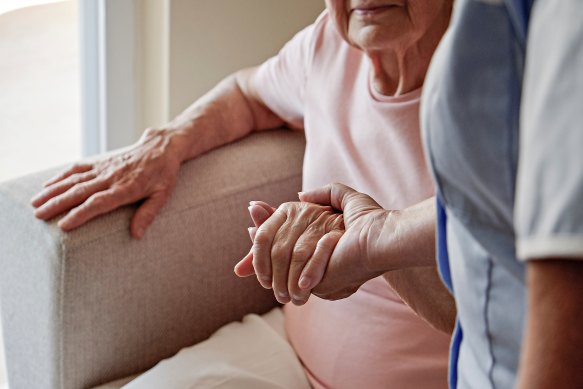Older Australians with large superannuation balances or high-value properties should be paying more for aged care, several major providers say, while warning that any new tax to help fund the ailing sector must be fair to younger generations.
The federal government is probing how it can inject more money into aged care to raise standards and keep up with rising costs, as Baby Boomers enter the system with higher expectations while the taxpaying workforce declines as a portion of the population.

The federal government is probing how it can inject more money into aged care to raise standards and keep up with rising costs.
A taskforce established last month by Aged Care Minister Anika Wells has been charged with considering whether options such as taxpayer levies and consumer contributions could lift quality in a system already costing the government more than $30 billion a year.
Uniting NSW.ACT executive director Tracey Burton said the taskforce would take up the “unfinished business” of the aged care royal commission, which two years ago recommended a raft of ways to improve care but could not agree on how to fund them.
Commissioner Tony Pagone backed a Medicare-style levy that was spent solely on aged care, while Commissioner Lynelle Briggs recommended a general levy of 1 per cent to go into federal coffers and support the sector.
However, Burton said greater consumer contributions using superannuation or accumulated wealth in the home made the most sense as a starting point.
“You can’t be moving a system from three-star to four-star [services] without additional resources. And it can’t all just be at the cost of the taxpayer,” she said.
“With a diminishing taxpayer base, we have competing demands for taxpayer revenue. We want good education, good schools, we’ve got debt to repay after COVID … finding other ways is really important.
“Superannuation was put in place to allow people to have a dignified life in retirement, and that includes the last couple of years ... why wouldn’t you use it to fund the costs of [things like] housing and cleaning that you’ve incurred your whole life?”
Burton said she thought the taskforce could recommend a combination of both a levy and consumer contributions, particularly since there were many older Australians who could not afford to pay more.
But she said any levy would have to be carefully designed to make sure there were no unintended consequences that worsened intergenerational inequity.
Peak body Catholic Health Australia’s director of aged care, Jason Kara, said it was good the government was considering all options, but it was unlikely that unlimited taxation income would be directed towards aged care.
“We think the most appropriate thing to do is charge more to those who can afford it, with a strong safety net,” he said.
That could involve means-testing a person’s family home above the current capped amount, which is $193,000, and lifting the maximum daily fee people pay from $59.
He said there were intergenerational equity concerns when considering a levy.
“[It would be] a massive step-up in investment to provide care for what is quite a wealthy generation, by a generation that is starting to show signs of pressure,” he said.
Opal HealthCare chief executive Rachel Argaman said the Baby Boomer generation had been willing to pay more for things they valued, including healthcare.
“It makes sense that those who can afford it should be able to pay more, on a means-adjusted basis, for accommodation, meals and non-care related costs,” she said.
UnitingCare Australia national director Claerwen Little also said her organisation believed those who could afford to pay more, should pay more.
“But crucially, we must ensure that everyone has access to high-quality care, especially the most vulnerable,” she said.
Tom Symondson, chief executive of the Aged and Community Care Providers Association and a taskforce member, said the biggest question it faced was how to pay for aged care in a sustainable way that also met consumers’ quality expectations.
He acknowledged the royal commission had recommended some form of levy but said other options were also on the table, including increased contributions for those who can afford it.
“Is it fair that someone in a $10 million mansion pays the same as someone with a modest home in the suburbs? Should a portion of superannuation be used to help older Australians receive the care and support they need? Are people willing to forgo some of their inheritance to ensure their parents get the best possible care?
“All these questions will be asked, and will require a conversation with all Australians on the possible answers.”
Grant Corderoy, a senior partner at consultancy StewartBrown and another taskforce member, said staffing shortages, the ageing population and rising cases of dementia were key drivers of aged care costs.
He said greater consumer contributions needed to be on the agenda, but it would be premature to say which funding solution would be best.
“There are pros and cons with any of the options. Each has its supporters or otherwise. I think the taskforce will stick to the basic principle: we want to ensure the quality of care improves and there is sufficient funding to enable that to occur, as well as investment and innovation in the sector,” Corderoy said.
“The issue for the government is they want to make certain there is a safety net. We need to always make sure the financially vulnerable are looked after.”
Council on the Ageing chief executive and taskforce member Patricia Sparrow said all options needed to be considered.
“Older people have different financial means and capacity to pay. Funding and sustainability are key issues where government needs to hear from the people these decisions will affect,” she said.
Cut through the noise of federal politics with news, views and expert analysis from Jacqueline Maley. Subscribers can sign up to our weekly Inside Politics newsletter here.